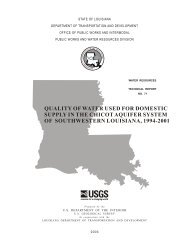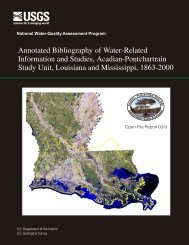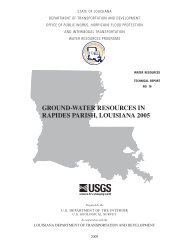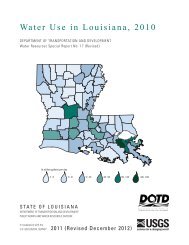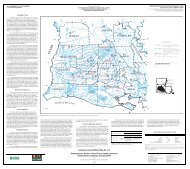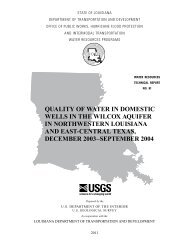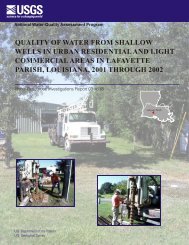environmental setting, water quality, and ecological indicators of
environmental setting, water quality, and ecological indicators of
environmental setting, water quality, and ecological indicators of
You also want an ePaper? Increase the reach of your titles
YUMPU automatically turns print PDFs into web optimized ePapers that Google loves.
Stream habitat ratings using RBP habitat characterizations<br />
were rated optimal to marginal for all <strong>ecological</strong><br />
data-collection sites; ratings for 16 sites<br />
were rated optimal to suboptimal.<br />
Generally, median bank erosion scores <strong>and</strong> median<br />
measurements <strong>of</strong> bankfull <strong>and</strong> wetted channel<br />
widths were greatest at all site groups with large<br />
drainage areas.<br />
Generally, the median bank stability index <strong>and</strong> pool<br />
substrate characterization score were lowest at all<br />
site groups with high agricultural intensity.<br />
Median values were lowest for 17 <strong>water</strong>-<strong>quality</strong><br />
variables at group A sites <strong>and</strong> highest for 11 <strong>water</strong><strong>quality</strong><br />
variables at group B sites.<br />
Possible explanations for the differences in <strong>water</strong><br />
<strong>quality</strong> among site groups include the differences in<br />
general soil types <strong>and</strong> agricultural l<strong>and</strong> use in these<br />
basins.<br />
Increased turbidity <strong>and</strong> concentrations <strong>of</strong> nutrients<br />
<strong>and</strong> insecticides, which normally are associated<br />
with agricultural activities, occurred at group C<br />
sites.<br />
Water clarity <strong>and</strong> the amount <strong>of</strong> open canopy differed<br />
among CCA site groups.<br />
Organisms tolerant <strong>of</strong> turbidity, organic enrichment,<br />
<strong>and</strong> low dissolved-oxygen concentrations are common<br />
in the study <strong>and</strong> dominated the aquatic invertebrate<br />
community.<br />
Aquatic invertebrate communities at large-basin<br />
sites tended to vary along the dissolved-oxygen <strong>and</strong><br />
open-canopy gradient, whereas communities at<br />
small-basin sites tended to vary along the instreamcover<br />
<strong>and</strong> fipronil-concentration gradient.<br />
Aquatic invertebrate communities were significantly<br />
different in percentage <strong>of</strong> noninsects, abundance<br />
a<strong>of</strong> midge taxa, abundance <strong>of</strong> feeding groups,<br />
<strong>and</strong> number <strong>of</strong> tolerant organisms among intensity<br />
<strong>and</strong> CCA site groups.<br />
Diversity metrics were similar among study-design<br />
site groups but significant differences in dominance<br />
<strong>and</strong> diversity occurred among CCA site groups.<br />
In this study, the maximum concentration <strong>of</strong> dissolved<br />
fipronil was the only significant <strong>environmental</strong><br />
variable related to consistent decreases in<br />
relative abundance for many species, notably<br />
midges.<br />
Relative abundances for many species decreased at<br />
lower concentrations <strong>of</strong> the fipronil degradation<br />
products (fipronil sulfone, fipronil sulfide, <strong>and</strong> desulfinylfipronil)<br />
than <strong>of</strong> the fipronil parent compound.<br />
44<br />
REFERENCES CITED<br />
Ali, Arshad, Nayar, J.K., <strong>and</strong> Gu, W.D., 1998, Toxicity<br />
<strong>of</strong> a phenyl pyrazole insecticide, fipronil, to mosquito<br />
<strong>and</strong> chironomid midge larvae in the laboratory:<br />
Journal <strong>of</strong> the American Mosquito Control Assoc.,<br />
v. 14, no. 2, p. 216-218.<br />
Allain, Larry, Vidrine, Malcolm, Grafe, Vicki, Allen,<br />
Charles, <strong>and</strong> Johnson, Steve, 2000, Paradise lost? The<br />
Coastal Prairie <strong>of</strong> Louisiana <strong>and</strong> Texas: U.S. Fish <strong>and</strong><br />
Wildlife Service, 39 p.<br />
Avery, Jimmy, <strong>and</strong> Lorio, Wendell, 1999, Louisiana<br />
Cooperative Extension Service, Crawfish production<br />
manual: Baton Rouge, La., Louisiana State University<br />
Agricultural Center, Pub. 2637, 38 p.<br />
Barbour, M.T., Gerritsen, Jeroen, Snyder, B.D., <strong>and</strong><br />
Stribling, J.B., 1999, Rapid Bioassessment Protocols<br />
for use in streams <strong>and</strong> wadeable rivers—Periphyton,<br />
benthic macroinvertebrates <strong>and</strong> fish (2d ed.):<br />
Washington, D.C., U.S. Environmental Protection<br />
Agency, Office <strong>of</strong> Water, EPA-841-B-99-002, 339 p.<br />
Brower, J.E., <strong>and</strong> Zar, J.H., 1984, Field <strong>and</strong> laboratory<br />
methods for general ecology (2d ed.): Dubuque, Iowa,<br />
Wm. C. Brown Publishers, p. 226.<br />
Brown, C.A., 1972, Wildflowers <strong>of</strong> Louisiana <strong>and</strong><br />
adjoining states: Baton Rouge, La., Louisiana State<br />
University Press, 247 p.<br />
Canadian Council <strong>of</strong> Ministers <strong>of</strong> the Environment,<br />
1999, Canadian <strong>environmental</strong> <strong>quality</strong> guidelines,<br />
Canadian sediment <strong>quality</strong> guidelines for the<br />
protection <strong>of</strong> aquatic life—Summary tables, exerpt<br />
from Publication no. 1299, ISBN 1-896997-34-1:<br />
accessed March 1, 2001, at URL<br />
http://www.ec.gc.ca/ceqg-rcqe/sedtbl_e.PDF<br />
Canadian Council <strong>of</strong> Ministers <strong>of</strong> the Environment,<br />
2001, Canadian <strong>water</strong> <strong>quality</strong> guidelines for the<br />
protection <strong>of</strong> aquatic life—Summary table, Canadian<br />
<strong>environmental</strong> <strong>quality</strong> guidelines, 1999: Winnipeg,<br />
Canadian Council <strong>of</strong> Ministers <strong>of</strong> the Environment,<br />
7p.<br />
Connelly, Pete, 2001, Environmental fate <strong>of</strong> fipronil:<br />
California Environmental Protection Agency, Department<br />
<strong>of</strong> Pesticide Regulation: accessed on October 16,<br />
2002, at URL<br />
http://www.pw.ucr.edu/textfiles/fipronil.pdf<br />
Cuffney, T.F., Gurtz, M.E., <strong>and</strong> Meador, M.R., 1993,<br />
Methods for collecting benthic invertebrate samples as<br />
part <strong>of</strong> the National Water-Quality Assessment Program:<br />
U.S. Geological Survey Open-File Report 93-<br />
406, 66 p.



